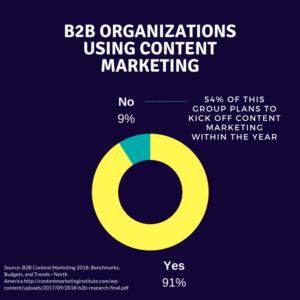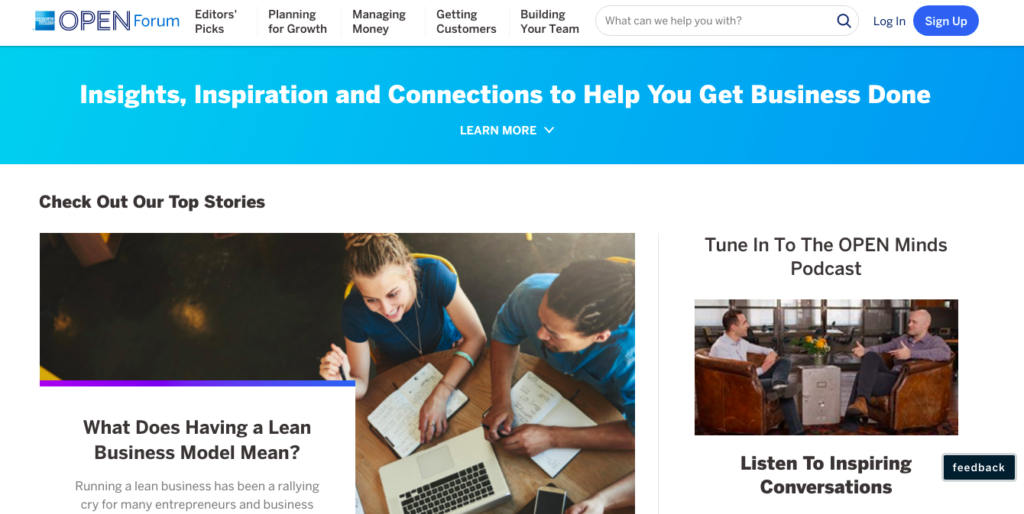Table of Contents
Last Updated on August 3, 2023 by admin
Fact: Companies are digging their heels in when it comes to content marketing:
Why the surge in content marketing? Because it’s a tried and true way to increase brand awareness, build trust, and develop authority.
Which is also what makes it a perfect strategy for the fintech industry.
We previously talked about how great content can power explosive growth for fintech companies. Disruption has become a constant in financial services with new technologies emerging daily that change the way we pay, bank, manage wealth, and insure things. This fast-paced movement and high-tech ecosystem can be inherently confusing.
Fintech as an industry has to overcome some challenges in the growth stages, including some of the surrounding confusion. Content marketing is a vehicle for building trust to get buy-in from businesses and consumers alike. It’s also a great way to educate the masses about new technology and to drive awareness. Ultimately, it can be an effective tool to drive revenue.
The key word here is effective. So the natural question is “How do we ensure our content marketing is effective?”
Great question. We’ve got you covered.
Water, Water Everywhere and Not a Drop to Drink
If you’re familiar with the The Rime of the Ancient Mariner, you know the poor (thirsty) sailors were stuck on a motionless ship, taunted by the surrounding salt water, none of which they could drink. Some organizations are in a similar predicament with their content. They have a ton of it. They’ve written libraries of ebooks and white papers, spent thousands on beautifully animated and narrated videos and created other content pieces galore.
The problem is that it’s all stashed away in silos and disparate marketing channels, none of it working together to achieve the overarching marketing goal or business objective. It lays heavy around the neck of its creators, much like an albatross.
Any organization that has been blogging, creating ebooks or white papers, posting videos, or creating dazzling infographics has probably felt a little seasick, so to speak. After you get rolling with a content marketing program, a new obstacle becomes: how do we organize all of this?
This is an important question because organization is key to effective distribution/promotion (traffic generation), lead generation, and data gathering (insights on your audience).
Fintech companies in the thick of growth hacking and working on limited budgets to do the most with marketing can lose track of the goals they seek to achieve with great content. Disorganization is the number one culprit.
Figuring out how to organize your content also makes it easier for internal teams to manage and govern content effectively. Most importantly, organizing your content is important because it helps you foster an owned online environment that yields a positive and engaging experience for the end user.
Organization is King – Rule with a Fintech Content Hub
First, let’s start with a fintech content hub is — and isn’t. It isn’t just another place to publish content. Instead, think of it as a “center of activity” for the content you have created — and will create. In many cases, your content is dispersed across channels. You probably have articles on your blog (as part of your website/CMS), videos on YouTube or Vimeo, infographics and other visuals on social media channels, and white papers or other PDF downloads that may even live on third party websites or landing pages.
A fintech content hub is a way to bring all this content to a single location and make it searchable and easily engageable for your audience. Rather than sending people off your site to view all of your videos, you can have them organized by vertical, topic, most-viewed, or date on your own site. By aggregating all content into one nucleus, you can organize all your content in this way, making it easier for users to find, view, and engage with the content they want and need.
The benefits for your brand (and its team of marketers) and your users are hard to miss:
| What YOU Do | What YOUR USERS Get |
| Make your content more discoverable – all your content is in one, format-agnostic place | Easy, findable answers to their most pressing questions. They can search by topics and most popular content rather than by media or format (forcing them to other channels) |
| Spend less time on channel management and more time on providing quality content | Enjoy high quality content on one platform. Can view messaging and consume content via their preferred medium. |
| Provider broader messaging and deeper insights, all in a central location. | Fully branded, contextual experience allows users to dig further into topics without navigating between sites or channels. All the information is in one place. |
Hot Tips & Takeaways
Whether your fintech content hub is purely for marketing reasons or another purpose (sales enablement, knowledge bases, etc.), it can help you enrich your content by aggregating and organizing it to provide the user with additional context. The following best practices can help you ensure your getting the maximum impact from your high quality content.
Aggregate & Curate Content
Provide more points of entry to your content and your brand by aggregating all content types in one central location. This includes:
- Videos
- Infographics
- Calculators
- Interactive Content
- Blog Posts
- White Papers
- eBooks
- Social Media Posts
- RSS & Other Curated Content
- User Generated Content (UGC)
Nail Organization
While all your content should be available in one place, you need to strategically organize so that users can easily search and discover the content they want. This may require some internal discussions to find the best methodology. You may want to organize by:
- Audience Persona: If you’ve done the legwork on putting together an audience persona, this can be a great way to organize content. This can be sliced several different ways. You may want to angle content pieces by job title (CTO, CMO, CEO) or by business size or by both. It will depend upon how in-depth your persona research is and how detailed you want to be in catering to your core audiences.
- Topic or Keyword: If your content can easily be broken into topics or highly searched keywords, this can be a helpful way to organize content for users who are seeking answers to a specific subject or issue. Bonus points if you can organize by an action item (“Simplify Payment Processing”)
- Industry or Vertical: For B2B organizations that work across several verticals or niches, consider organizing by such.
Play to Your Strengths
Avoid creating content for the sake of creating content. Instead, play to your strengths as a brand. Since fintech (and technology in general) is geared towards simplifying processes for your customers/clients, the content you produce should do the same. This means choosing the right medium and format is important. Authoritative, long-form articles are great, but don’t just focus there if your audience is searching for calculators and other interactive tools to make their lives easier. Similarly, if you’re niche is B2B fintech, balance blogging with more bottom of the funnel content like case studies. Finding the right mix can be a complex process, which is why step 1 should always be mapping out a content marketing strategy.
Add Your Personal Touch
Don’t forget to brand your fintech content hub. It should provide a consistent brand experience that meshes well with the rest of your site and your overall digital brand experience. Some items to consider:
- Brand tone & voice guide
- Colors, fonts, & CTAs
- Image styles & sizes
- Slide deck themes
- Landing page templates
- White paper/ebook templates
- Infographic templates
- Iconography & any brand symbols, including logo
- Whether copy uses MLA, APA, or another writing style guide
- Other internal branding guidelines
Hat Tips & Killer Fintech Content Hub Examples
A natural question might be “So who’s doing it right?” While there’s no one right formula to correctly set up a fintech content hub, there are brands that have done a standout job in presenting content to users.
American Express OPEN Forum
One of the best examples of a stellar fintech content hub is American Express’ OPEN Forum. As a branded community, the site caters to its core audience: small business owners.
OPEN forum takes a somewhat unique angle in that it has found a way to make the site almost self-supporting, enlisting its members to supply some of its rich content.
According to Courtney Colwell, director of OPEN Forum and content marketing at American Express, the goal is “content as community,” which promotes support of small business owners by small business owners via content created within the community.
Another tactic the brand uses is to work with Amex-holding influencers, who bring a unique perspective along with their own curated audience. It’s a win-win because the influencers add personality and a fresh point of view that supports the Amex brand, and they also broaden the reach and widen the audience by adding their own followers, fans, and readers to the mix.
Betterment
Betterment, a brand we’ve touched on before, is another great example of how to organize and present content to your users. Betterment offers a variety of content types (including interactive content), allowing their users to browse based on their information needs (e.g. Retirement, Investing 101, etc.).
In addition to written content, Betterment provides tools and calculators, making them an active participant with users in planning out their financial strategy. It’s an incredibly useful and helpful hub and bookmark-worthy. That’s really the key: to be so useful and necessary that your users bookmark you and return to you time and time again because you’re the best reference point available.
These are two brilliant examples how to kick a fintech content hub in action, but you can find more examples of great Fintech content hubs in this article, too.
End Game: Optimized User Experience
Whether you’re starting small and just thinking about building a fintech content hub or have a mountain of content you’re looking to organize, the number 1 goal should be to provide an optimal user experience. In order to achieve your marketing and business objectives, an excellent user experience is foundational. Your audience will not engage with, return to, or provide personal information for content that doesn’t cater to their needs.
Providing value to your audience is about more than aggregating all your content in one place. Taking all the above considerations into account provides a streamlined, rich brand experience that will keep people coming back for more. Keep the user experience in the forefront of your mind to build a highly effective fintech content marketing hub.









1 thought on “How to Build a Fintech Content Hub (With Examples & Tips!)”
Pingback: Android App Marketing Tips for 2019 | richtech.solutions